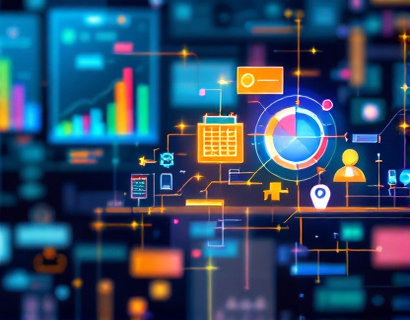AI-Driven Mental Health Insights: Transforming Access to Psychiatric Services
The integration of artificial intelligence in mental health services has opened new avenues for providing specialized insights and support to a diverse audience. An AI-powered chatbot, designed with a focus on accuracy and safety, stands as a beacon of hope for children, students, educators, and healthcare professionals seeking reliable information on psychiatric services and mental health. This article delves into the capabilities and significance of such a platform, emphasizing its role in democratizing access to mental health resources.
Understanding the Need for AI in Mental Health
Mental health issues affect millions worldwide, yet access to specialized care remains a challenge for many. Traditional methods of seeking help often involve long wait times, stigma, and limited availability of professionals. The introduction of AI-driven solutions addresses these gaps by offering immediate, confidential, and expert-driven insights. An AI chatbot tailored for mental health can provide a first line of support, guiding users to appropriate resources and professional help when needed.
Specialized Insights for a Broad Audience
The chatbot is designed to cater to a wide range of users, each with unique needs and levels of understanding. For children and students, the content is simplified and presented in an engaging manner, ensuring they can grasp complex concepts without feeling overwhelmed. Educators and healthcare professionals benefit from more detailed information, including the latest research, treatment options, and industry updates. This tiered approach ensures that all users receive information that is both accessible and comprehensive.
Content Verification for Safety and Accuracy
One of the most critical features of this AI chatbot is its commitment to content verification. Mental health information must be accurate and up-to-date to prevent misinformation and ensure user safety. The platform employs a rigorous review process, involving mental health experts and professionals, to validate all content. This ensures that users, especially children and students, receive reliable and safe information. The verification process also helps in maintaining the credibility of the platform, fostering trust among its users.
Empowering Users with Knowledge
The AI chatbot serves as an educational tool, empowering users to take an active role in their mental health journey. By providing detailed explanations of various psychiatric conditions, treatment options, and self-care strategies, the chatbot equips users with the knowledge to make informed decisions. For students, this means better understanding of mental health topics, which can be integrated into school curricula or personal learning. Educators can use the platform to enhance their knowledge and better support their students.
For healthcare professionals, the chatbot offers a continuous learning resource, keeping them updated on the latest research and best practices. This not only improves their competence but also enhances the quality of care they provide to patients. The platform's ability to adapt to user needs and provide personalized insights makes it an invaluable tool for continuous education and professional development.
Interactive and User-Friendly Interface
The chatbot's design prioritizes user experience, ensuring that interactions are smooth and intuitive. The AI uses natural language processing to understand and respond to user queries effectively. This capability allows users to engage in conversations as they would with a human expert, reducing the intimidation factor often associated with seeking mental health help. The interface is also optimized for various devices, making it accessible on smartphones, tablets, and computers.
For children and students, the interface is particularly child-friendly, with visual elements and simplified language. This approach not only makes the platform more engaging but also helps in building a positive association with mental health topics from a young age. The chatbot can answer questions, provide reassurance, and guide users to appropriate resources, all while maintaining a supportive and non-judgmental tone.
Supporting Mental Health Enthusiasts and the Broader Community
The benefits of this AI-driven chatbot extend beyond immediate users to the broader community interested in mental health. Mental health enthusiasts can find in-depth articles, research summaries, and expert opinions on various topics. This content not only educates but also helps in breaking down stigmas surrounding mental health issues. By promoting open discussions and sharing reliable information, the platform contributes to a more informed and empathetic society.
For educators, the chatbot serves as a valuable resource for integrating mental health education into their teaching. Lesson plans, activity ideas, and discussion prompts can be easily accessed, helping to create a supportive and informed school environment. This proactive approach to mental health education can have long-term benefits for students, fostering resilience and emotional well-being.
Collaboration with Mental Health Professionals
The development and maintenance of the chatbot involve close collaboration with mental health professionals, ensuring that the information provided is not only accurate but also aligned with current best practices. These experts review and update the content regularly, incorporating new findings and treatment approaches. This ongoing collaboration ensures that the platform remains a trusted and authoritative source of mental health information.
Healthcare professionals can also use the chatbot to refer patients to relevant resources, supplementing their own practice with additional support tools. The chatbot can provide detailed information on local services, support groups, and treatment options, making it easier for professionals to guide their patients effectively.
Addressing Specific Needs of Different User Groups
Understanding the unique needs of different user groups is crucial for the chatbot's effectiveness. For children, the content is tailored to be age-appropriate, using simple language and relatable examples. The chatbot can answer common questions about feelings, stress management, and coping strategies, providing a safe space for young users to express themselves.
Students, particularly those in higher education, face unique mental health challenges related to academic pressure, social life, and future uncertainties. The chatbot offers targeted advice on managing stress, time management, and seeking help when needed. It can also provide information on campus resources and support services, helping students navigate their mental health journey within the academic environment.
For educators, the chatbot serves as a tool for professional development, offering insights into the mental health needs of students and effective strategies for support. It can provide information on recognizing signs of distress, creating inclusive classrooms, and fostering a supportive school culture. This knowledge empowers educators to create a more nurturing and understanding environment.
Ensuring Safety and Ethical Considerations
While the chatbot is a powerful tool, it is essential to address safety and ethical considerations. The platform includes strict privacy policies to protect user data and ensure confidentiality. Users can interact anonymously if they prefer, which is particularly important for sensitive topics like mental health. The chatbot also includes clear guidelines on when to seek professional help and provides emergency contact information for critical situations.
Ethical considerations are at the forefront of the chatbot's design, ensuring that it does not replace professional help but rather complements it. The platform clearly communicates its limitations and encourages users to seek human assistance when necessary. This balanced approach helps in building trust and ensuring that users receive the appropriate level of support.
Future Prospects and Continuous Improvement
The future of AI-driven mental health support is promising, with ongoing advancements in AI technology and a growing recognition of its potential in healthcare. The chatbot will continue to evolve, incorporating feedback from users and experts to enhance its capabilities. Future updates may include more advanced emotional analysis, personalized recommendations based on user history, and integration with wearable devices for real-time monitoring.
As the platform grows, it will also expand its reach, partnering with schools, universities, and healthcare organizations to integrate mental health support into existing systems. This collaborative approach can help in creating a more comprehensive and accessible mental health network, benefiting a wider audience.
In conclusion, an AI-driven chatbot for mental health services represents a significant step forward in making specialized insights and support more accessible. By focusing on accuracy, safety, and user engagement, such a platform can play a vital role in improving mental health outcomes for children, students, educators, and healthcare professionals alike. As we continue to navigate the challenges of mental health, innovative solutions like this chatbot offer hope and a path toward better support and understanding.











































